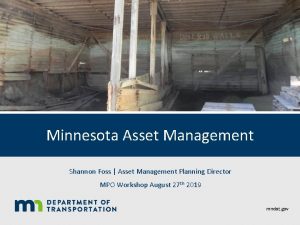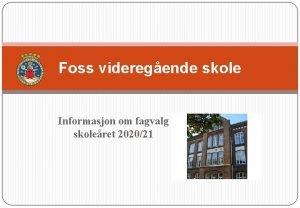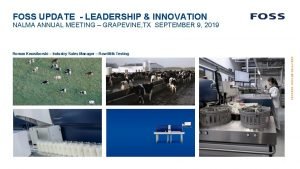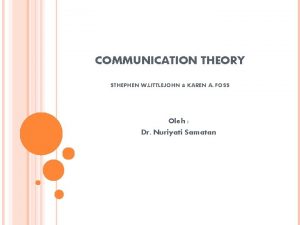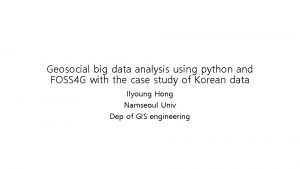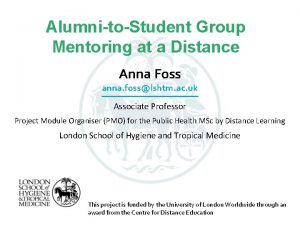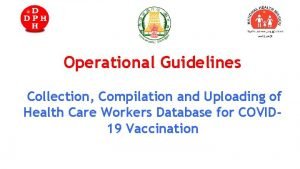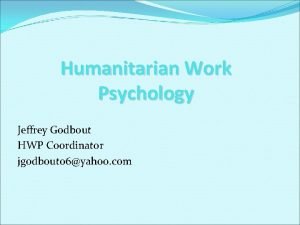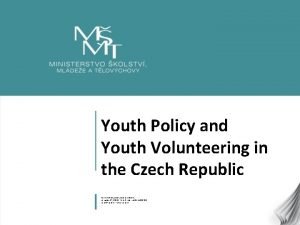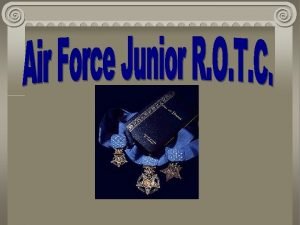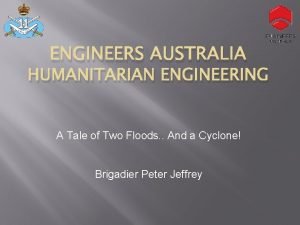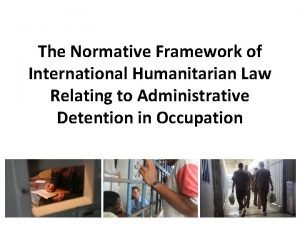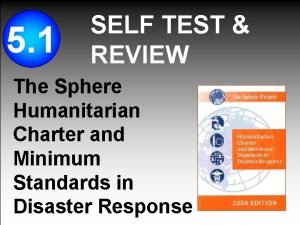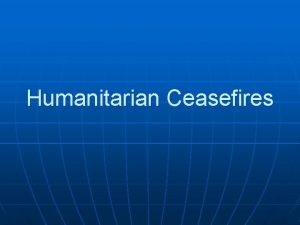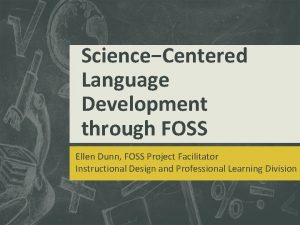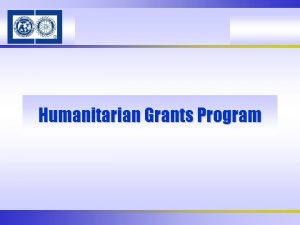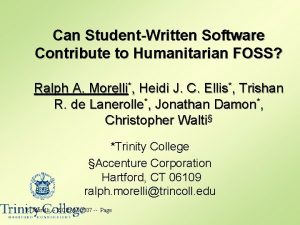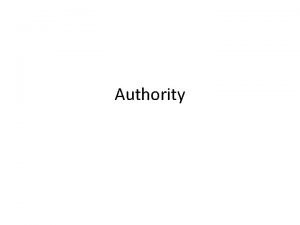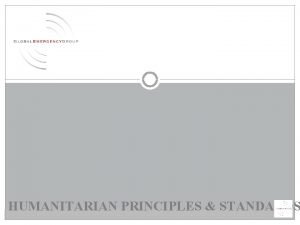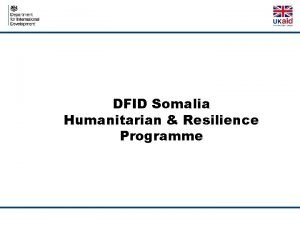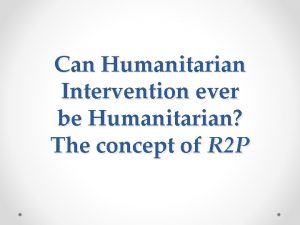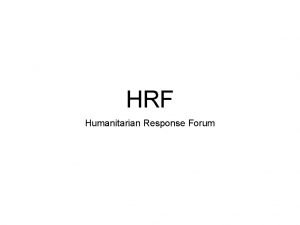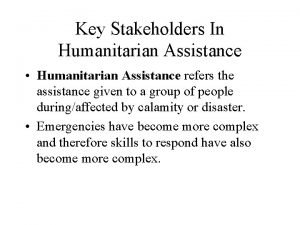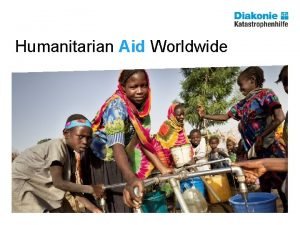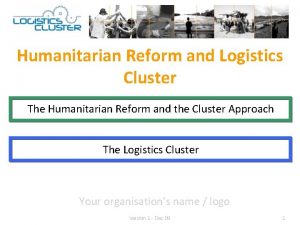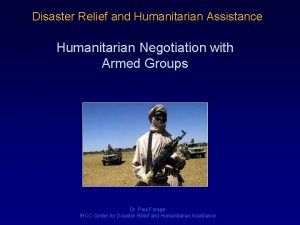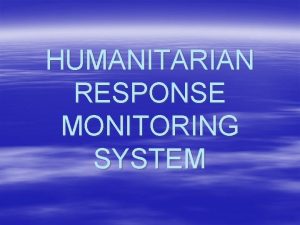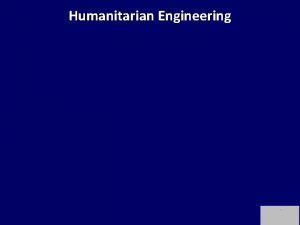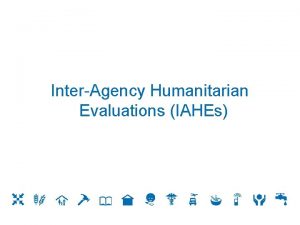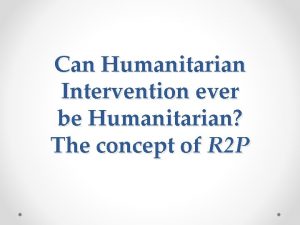Project Selection for Student Participation in Humanitarian FOSS



















































- Slides: 51

Project Selection for Student Participation in Humanitarian FOSS Heidi J. C. Ellis - ellis@wne. edu Gregory W. Hislop – hislop@drexel. edu Michelle Purcel - mjw 23@drexel. edu Darci Burdge, Lori Postner – NCC Stoney Jackson – WNE Sean Goggins – University of Missouri

1. Introductions Foss 2 serve. org Teaching. Open. Source. org 2

2. Set Up Etherpad: http: //openetherpad. org/SIGITE Workshop 3

3. What is HFOSS? 4

Free Software Definition • Free software is a matter of the users' freedom to run, copy, distribute, study, change and improve the software. • Four freedoms – To run the program, for any purpose – To study the program works, and change it – To redistribute copies – To distribute copies of your modified versions 5

Legal Mechanisms • How do you implement FOSS within the legal system? – FOSS is not Public Domain • Copyleft – Use copyright to control the material – Share the rights via license • “making a program (or other work) free, and requiring all modified and extended versions of the program to be free as well. ” • Implementation: GNU General Public License © 6

FOSS Today What has resulted from all this noise about FOSS?

FOSS Today 8

FOSS Today Many credible products; some market leaders 9

Control • Misconception of FOSS as “Free contribution by anyone” – NOT! – This would be chaos • Need for control creates a hierarchy – Version control enables and enforces – Committers – Contributors – Others 10

Control and Community • “Contributor Mountain” – Client/customer • Use in isolation – Seeker • Connects to community for answers on using – Collaborator • Contributes bug reports, feature requests, … – Contributor • Moves project forward • Relied on by the community 11

Community • Clients and developers as part of a spectrum – Not “us” vs. “them” • Assumption that people can move from passive “user” to active participant – Even without technical skills • See: “Why we won’t call you a ‘user’. ” – http: //www. kitware. com/blog/home/post/263

Community • Openness to new participants – Especially if you approach the project reasonably • Advancement via accomplishment – Fairly direct meritocracy • Check and balance – Control of commit authority • Real point of control for moving the product – Ability to fork • Limits autocratic power 13

Communication • More is generally better • Multiple channels – Highly distributed participation • Less elaborate; more immediate • Rollback mechanisms available (e. g. , in a wiki) – Synchronous and asynchronous – Low and high bandwidth • Explicit provision for lurkers – Replaces hallway conversations and discussion in the break room – Allows for serendipity and learning by osmosis

What is HFOSS • FOSS created to provide social benefit – Disaster recovery – Medical records – Economic development – Education – And more! • Extra potential to catch student interest! – And provide education on professional impact and responsibility 15

4. Student Participation 16

Challenges • FOSS project complexity – Code and technology base – Tools used • FOSS culture and process – Dynamics of interaction with FOSS communities – Release schedules and process • Meaningful involvement for students – FOSS project cooperation – Maintaining local knowledge of project over time

Learning Opportunities - Technical • Coding, testing and debugging • Code reading and understanding • Specification and design • Development platforms – E. g, mobile • Tools • http: //www. xcitegroup. org/softhum/doku. p hp? id=f: 50 ways

Learning Opportunities – Soft Skills • • • Teamwork Communication Cultural exposure Understanding of humanitarian issues Intellectual property

Learning Opportunities – Domain Knowledge • • • Health systems Financial systems Cryptography Bioinformatics Social issues

Students Have… • Created install instructions for the dev environment for Open. MRS • Added a keyboard to the Caribou onscreen keyboard • Written guidelines for downloading and installing products • Added color filters to vision software • Created a volunteer management module for disaster management software 21

Stories… • Volunteer registration at Strong Angel III • Invitation to conference in So. Africa • GNOME Summit 22

5. Locating Projects 23

Project Location 1. Peruse sites for potential projects – – – Sourceforge – sourceforge. net Git. Hub - github. com Launchpad - launchpad. net Ohloh - ohloh. net Gitorious - gitorious. org List of HFOSS projects: http: //www. xcitegroup. org/softhum/doku. php? id=g: hfoss_and _oss_projects 2. Identify 5 -6 potential projects 3. Narrow down to three most interesting • Other resources: Teaching. Open. Source. org and foss 2 serve. org

You Try It! • Start at ohloh. net – How much you can learn about Mifos in 10 minutes? – How many developers? Commit pattern? Activity? Who are the managers? – Language(s)? Size of code base? Technical docs? • Full activity: – http: //www. foss 2 serve. org/index. php/Intro_Proje ct_Identification_Activity 25

6. Evaluation Model Follow on using Mifos 26

The Model - 1

The Model - 2 • Rate criteria on scale of one to three – Three is “best” • Mission Critical Criteria: Must be present to support student success – No rating of less than two is acceptable • Secondary Criteria: Contribute to the success but lack does not lead to failure – Total score above 20 indicates a viable project 28

Mission Critical Viability – Size, Scale Complexity • Remember that students do not need to understand entire project • LOC: 96 KLOC – 5 MLOC – Very dependent on architecture • Architecture: Modular architectures best – E. g. , plug-in architecture • Number of committers: ~6 within the last 12 months 29

Mission Critical Viability – Activity • Commits per month: 10 -30 is reasonable – Look back a year or so for commit pattern – Projects may have cyclic commit pattern 30

Mission Critical Viability – Community • • • Active user and developer communities Regular history of project downloads Regular documentation updates Current activity on user mailing lists Be careful of: – Long lags between updates – Current questions unanswered on forums – No recent history of downloads 31

Mission Critical Approachability – On-ramp • Must have identifiable way for new people to contribute • Rubric: – Insufficient: few or no pointers on how to get involved – Sufficient: Suggestions about how to get involved other than contributing money – Ideal: Obvious link to getting started including list of tasks needed to be completed and detailed instructions 32

Mission Critical Suitability – Appropriate Artifacts • Must have artifacts/tasks that support learning for your class – Documentation, testing, design, coding, etc. – Multiple opportunities for a variety of different kinds of contributions is best 33

Mission Critical Suitability – Contributor Support • Ideal: Community provides lots of guidance • Project should contain information on how project is administered and managed • Communication tools clearly documented • Developers have a web presence • Processes for getting change committed, feature selection etc. well documented. • Responses to questions on IRC/list should be supportive and timely 34

Secondary Suitability – Domain and Maturity • Domain: Understandability can impact learning – E. g. , Software for Nuclear Magnetic Resonance vs. gaming software • Maturity: Should have at least one stable release – Otherwise project may not have sufficient organization to support student learning 35

Secondary Suitability – User Support & Roadmap • User Support: Clear instructions for downloading, installing and using product – FAQs, forums, and lists – Quality of end-user documentation • Does project have clear roadmap for future? – Provides students with understanding of forward direction 36

Secondary Approachability – Contribution Types and Openness • Support for multiple contribution types? – More is better • Openness to contributions – Does project accept external patches – Description of how to get changes committed – Identification of committers – Be wary of projects that do not accept changes not from core members 37

Secondary Approachability – Student Friendliness • Ideal project welcomes and values student contributions – Check tone of discussion on IRC and forums – Is “flaming” is tolerated? • Evidence of previous student participation is helpful – E. g. , Google Summer of Code 38

Secondary Suitability • Product: Students must be able to understand what product does • Platform: Do you have support for platform project runs on? • Development features: – Programming language – Development environment – Supporting technologies: database packages, libraries, etc. 39

Other Factors • Sizzle! Is project attractive to students? • Long-term prospects: Is this a project that could be used for more than one term? • Ownership: Does project hold possibility for students to have a sense of “ownership”? – Will students want to follow the project during future development? 40

Project Evaluation Activity • http: //foss 2 serve. org/index. php/Project _Evaluation_Activity 41

7. Getting Started 42

Getting Started Step 1: Getting Organized - 1 • Project evaluation activities should help you identify possible HFOSS projects. • Cursory examination for: Project Wiki/Page Committers Mailing list(s) Bug Tracking Roadmap Source Code Control Documentation Releases IRC 43

Getting Started Step 1: Getting Organized - 2 • Think about kinds of deliverables for students. • Find Roadmap/bug tracker and identify possible contributions. – See if you can trace the process of one or more bug fixes or enhancements 44

Getting Started Step 2: Lurking • Join mailing list(s) and observe for several weeks. – Read logs for several months or year back – Who are the major community members and what are their roles? • Join IRC and lurk. • Identify meeting times and lurk in meetings. – What are the areas of interest to the community? 45

Getting Started Step 3: Introducing Yourself - 1 • Introduce yourself and your motivation for joining the group. • Identify what you (and students) can contribute to the project. – Not details, but generalities (e. g. , work on documentation) • Describe the student body that you’ll be introducing to the community. 46

Getting Started Step 3: Introducing Yourself - 2 • Identify what you are looking for from the community. – Project ideas? – Contact for particular aspect (e. g. , documentation) • Remember, goal is to facilitate student entrance into the community, not “find a project”. 47

Getting Started Step 4: Finding Things To Do – 1 • Identify a small task that you can accomplish. – Identify the committer and commit process for the task • Let the community know what you’re working on. • Accomplish the task and get it committed! 48

8. Wrap Up Want to join us? ? POSSE 49

Questions? • Links: – Foss 2 serve – http: //foss 2 serve. org – Teaching Open Source – http: //teachingopensource. org – http: //HFOSS. org – Producing Open Source Software http: //producingoss. com/ – The Cathedral and The Bazaar http: //catb. org/~esr/writings/homesteading/ – http: //Open. Souce. com – http: //openhatch. org

Licensed Under Creative Commons • Attribution-Share. Alike 3. 0 Unported (CC BY-SA 3. 0) • Users of this material are able remix, tweak, and build upon this work even for commercial purposes, as long as they credit the contributors and license their new creations under the identical terms. All new works based on this material will carry the same license, so any derivatives will also allow commercial use. • http: //creativecommons. org/licenses/bysa/3. 0/ 51
 Mapping cardinality
Mapping cardinality Shannon foss
Shannon foss Foss programfag
Foss programfag Combifoss 7
Combifoss 7 Foss chemical interactions
Foss chemical interactions Attatchment theory
Attatchment theory Diana foss
Diana foss Hanne foss hansen
Hanne foss hansen Nltk korean
Nltk korean Combifoss
Combifoss Anna foss
Anna foss Ee.humanitarian response.info/x/vpdlixjf
Ee.humanitarian response.info/x/vpdlixjf Humanitarian work psychology
Humanitarian work psychology Humanitarian projects in prague for youth
Humanitarian projects in prague for youth Humanitarian
Humanitarian Humanitarian programme cycle
Humanitarian programme cycle Longevity ribbon jrotc
Longevity ribbon jrotc Aerospace education foundation badge
Aerospace education foundation badge Humanitarian engineers in cape york
Humanitarian engineers in cape york International humanitarian law icrc
International humanitarian law icrc International humanitarian law icrc
International humanitarian law icrc International humanitarian law notes
International humanitarian law notes Khalifa humanitarian foundation
Khalifa humanitarian foundation Domistan
Domistan Humanitarian work psychology
Humanitarian work psychology Balancing selection vs stabilizing selection
Balancing selection vs stabilizing selection Artificial selection vs natural selection
Artificial selection vs natural selection K selected
K selected Natural selection vs artificial selection
Natural selection vs artificial selection Artificial selection vs natural selection
Artificial selection vs natural selection Directional selection
Directional selection Clumped dispersion
Clumped dispersion Natural selection vs artificial selection
Natural selection vs artificial selection Two way selection and multiway selection in c
Two way selection and multiway selection in c Two way selection and multiway selection in c
Two way selection and multiway selection in c Mass selection
Mass selection Fspos vägledning för kontinuitetshantering
Fspos vägledning för kontinuitetshantering Novell typiska drag
Novell typiska drag Tack för att ni lyssnade bild
Tack för att ni lyssnade bild Vad står k.r.å.k.a.n för
Vad står k.r.å.k.a.n för Varför kallas perioden 1918-1939 för mellankrigstiden
Varför kallas perioden 1918-1939 för mellankrigstiden En lathund för arbete med kontinuitetshantering
En lathund för arbete med kontinuitetshantering Underlag för särskild löneskatt på pensionskostnader
Underlag för särskild löneskatt på pensionskostnader Tidböcker
Tidböcker Anatomi organ reproduksi
Anatomi organ reproduksi Densitet vatten
Densitet vatten Datorkunskap för nybörjare
Datorkunskap för nybörjare Stig kerman
Stig kerman Att skriva debattartikel
Att skriva debattartikel Magnetsjukhus
Magnetsjukhus Nyckelkompetenser för livslångt lärande
Nyckelkompetenser för livslångt lärande Påbyggnader för flakfordon
Påbyggnader för flakfordon

